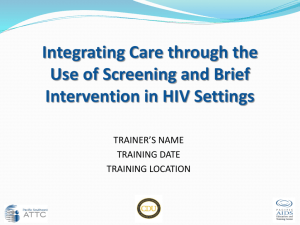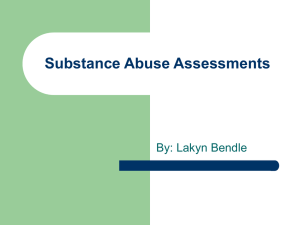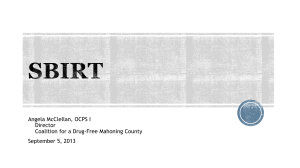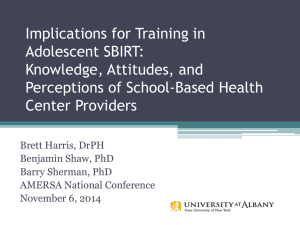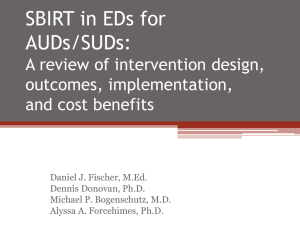PPT Presentation
advertisement
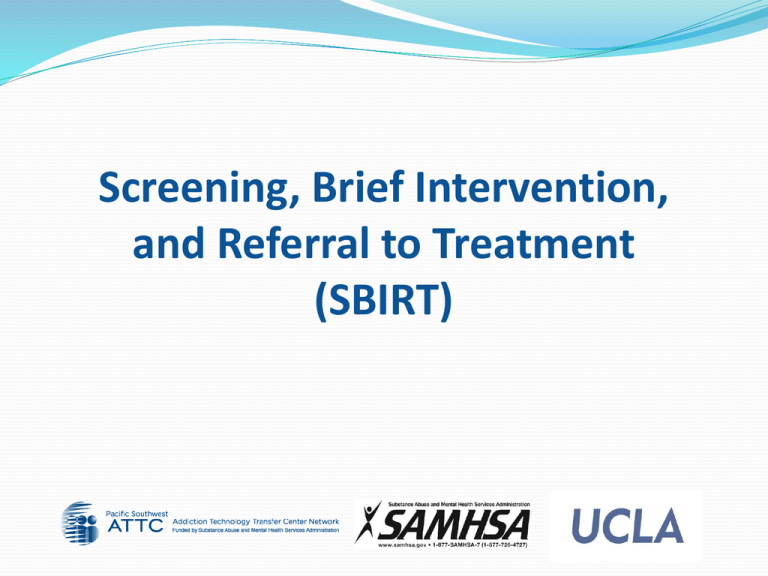
Screening, Brief Intervention, and Referral to Treatment (SBIRT) Our goal for this training is to instruct providers in specific SBIRT procedures and to develop participants’ skills to deliver SBIRT in their practices. Resources • • • Participants Educational materials from ATTCs and other centers Trainers Activities • • • • • Didactic learning Role plays Group discussions Brief assessment Links to additional training Outcomes • • • Develop skills to deliver SBIRT Discuss implementation challenges and possible solutions Integrate SBIRT in practice (long-term outcome) Please complete the pre-test. Thank you!! This course will teach you how to: • Administer screening • Deliver a brief intervention • Employ a motivational approach • Make referrals to specialized treatment Take some time to think about the most difficult change that you had to make in your life. How much time did it take you to move from considering that change to actually taking action? Screening: Very brief set of questions that identifies risk of substance use related problems. Brief Intervention: Brief counseling that raises awareness of risks and motivates client toward acknowledgement of problem. Brief Treatment: Cognitive behavioral work with clients who acknowledge risks and are seeking help. Referral: Procedures to help patients access specialized care. Substance abuse SBI may reduce alcohol and drug use significantly Morbidity and mortality SBI reduces accidents, injuries, trauma, emergency department visits, depression, drug-related infections and infectious diseases Health care costs Studies have indicated that SBI for alcohol saves $2 - $4 for each $1.00 expended Other outcomes SBI may reduce work-impairment, reduce DUIs, and improve neonatal outcomes • Increases clinicians’ awareness of substance use issues. • Offers clinicians more systematic approach to addressing substance use (less of a “judgment call”). “I had a vague idea on how to assess substance use, but now I think I have a lot more knowledge in these other areas. I know what to look for and it is a way to give me a gauge to see if the person is at risk and how to approach them [about that risk].” Mental health clinician, UCLA Counseling and Psychological Services Brief interventions are successful when clinicians relate patients’ risky substance use to improvement in patients’ overall health and wellbeing. “I just kind of relate it by saying…there’s just a big connection with mood and substance use, so I talk about that more as they could be someone who is anxious and they’re drinking or smoking pot. The drug use could be intensifying as a problem even if they are not identifying their use as a problem. So just pointing that out to them in a motivational interviewing way by saying, why don’t you track this and see what’s happening with your depression. And it just opens another way of talking about it. Sometimes you can see them glaze over and think, ‘‘Oh here we go with the alcohol and drug part.’’ But when you start linking it with mood and anxiety then they are like ‘Oh OK’.” Mental health clinician, UCLA Counseling and Psychological Services • • • • • College students Primary care patients Mental health patients Patients in infectious disease clinics People with alcohol- or drug-related legal offenses (e.g., DUI) Can SBIRT work in your setting? Screening to Identify Patients At Risk for Substance Use Problems What’s going on in these pictures? Assessment Screening Self-report • Interview • Self-administered questionnaires Biological markers • • • • Breathalyzer testing Blood alcohol levels Saliva or urine testing Serum drug testing See reference list • Brief (10 or fewer questions) • Flexible • Easy to administer, easy for patient • Addresses alcohol and other drugs • Indicates need for further assessment or intervention • Has good “sensitivity” and “specificity” • Provide historical picture • Inexpensive • Non-invasive • Highly sensitive for detecting potential problems or dependence Screen Target Population ASSIST (WHO) -Adults -Validated in many cultures and languages AUDIT (WHO) # Items Assessment Setting (most common) Type 8 Hazardous, harmful, or dependent drug use (including injection drug use) Primary Care Interview -Adults and adolescents -Validated in many cultures and languages 10 Identifies alcohol problem use and dependence. Can be used as a prescreen to identify patients in need of full screen/brief intervention -Different settings -AUDIT CPrimary Care (3 questions) Self-admin, Interview, or computerized DAST10 Adults 10 To identify drug-use problems in past year Different settings Self-admin or Interview CRAFFT Adolescents 6 To identify alcohol and drug abuse, risky behavior, & consequences of use Different settings Self-admin CAGE Adults and youth >16 4 -Signs of dependence, not risky use Primary Care Self-admin or Interview TWEAK Pregnant women 5 -Risky drinking during pregnancy. Based on CAGE. -Asks about number of drinks one can tolerate, alcohol dependence, & related problems Primary Care, Women’s organizations, etc. Self-admin, Interview, or computerized At-Risk Alcohol Use Men Women Older Adults (65 +) Per occasion >4 >3 >1 Per week >14 >7 >7 See reference list See reference list Pre-screening is a very quick approach to identifying people who need to do a longer screen and brief intervention. • Self-report, 1-4 questions • Biological, blood alcohol level test NIAAA 1-item for alcohol use “How many times in the past year have you had X or more drinks in a day?” • Identifies unhealthy alcohol use • Positive screen > 1 or more (provide BI) See reference list 5 for men 4 for women NIDA 1-item for illicit drug use "How many times in the past year have you used an illegal drug or used a prescription medication for non-medical reasons?” • Identifies overall drug use • Positive screen = 1 or more See reference list Complete Pre-Screen Alcohol: Women = 0 – 2 Men = 0 – 4 Alcohol Screen Complete Alcohol: Women = 4+ Men = 5+ Other Drugs: Any Yes Administer the AUDIT Administer the DAST Low/No Risk: Alcohol = 0 – 7 Other drugs = 0 At Risk: Alcohol = 8 – 15 Other drugs = 1 – 2 Mod/High Risk: Alcohol = 16 – 19 Other drugs = 3 – 5 Reinforce behavior; Monitor Brief Intervention Goal: Lower Risk; Reduce use to acceptable levels BI/Referral to tx/BT Goal: Encourage pt. to accept a referral to tx, or engage in BT Other Drugs: All Nos Other Drug Screen Complete High/Severe Risk: Alcohol = 20 – 40 Other drugs = 6 – 10 Referral to tx. Goal: Encourage pt. to accept referral to tx, or engage in BT • 10-question alcohol use screening instrument • Target groups include: • • Medical patients • Accident victims • DWI offenders • Mental health clients Designed for primary health care workers Hazardous Alcohol Use Question 1: Frequency Question 2: Typical of Drinking quantity Question 3: Frequency of heavy drinking Dependence Symptoms Question 4: Impaired control over drinking Question 5: Failure to meet expectations because of drinking Question 6: Morning drinking Harmful Consequences of Alcohol Use Question 7: Guilt after drinking Question 8: Blackouts Question 9: Alcohol-related Question 10: Others’ injuries concerns about drinking • I am going to ask you some personal questions about alcohol (and other drugs) that I ask all my patients. • Your responses will be confidential. • These questions help me to provide the best possible care. • You do not have to answer them if you are uncomfortable. See reference list Feedback? Reactions? Score Level Action 0-7 Low Encouragement 8-19 Low/Moderate BI 16-19 Moderate BI/RT 20+ High BT/RT Self-reports are more accurate when people are: • Alcohol- or drug-free when interviewed • Told that their information is confidential • Asked clearly worded, objective questions • Provided memory aides (calendars, response cards) See reference list Alcohol Screen Complete Administer the AUDIT Administer the DAST Low/No Risk: Alcohol = 0 – 7 Other drugs = 0 At Risk: Alcohol = 8 – 15 Other drugs = 1 – 2 Mod/High Risk: Alcohol = 16 – 19 Other drugs = 3 – 5 Reinforce behavior; Monitor Brief Intervention Goal: Lower Risk; Reduce use to acceptable levels BI/Referral to tx/BT Goal: Encourage pt. to accept a referral to tx, or engage in BT Other Drug Screen Complete High/Severe Risk: Alcohol = 20 – 40 Other drugs = 6 – 10 Referral to tx. Goal: Encourage pt. to accept referral to tx, or engage in BT Brief Interventions for Patients at Risk for Substance Use Problems “Brief opportunistic interventions are short, face-to-face conversations regarding drinking, motivation to change, and options for change which are provided during a window of opportunity or potentially teachable moment occasioned by a medical event.” See reference list FRAMES Personalized Feedback Responsibility Advice Menu of options Empathy Self-efficacy Awareness of problem Presenting problem Motivation Screening results Behavior change • Brief interventions trigger change. • A little counseling can lead to significant change, e.g., 5 min. has same impact as 20 min. • Research is less extensive for illicit drugs, but promising. • A randomized study with cocaine and heroin users found that patients who received a BI had 50% greater odds of abstinence at follow up compared with controls. See reference list What you do depends on where the patient is in the process of changing. The first step is to be able to identify where the patient is coming from. 1. Precontemplation Definition: Not yet considering change or is unwilling or unable to change. 6. Recurrence Definition: Primary Task: Raising Awareness 2. Contemplation Definition: Experienced a recurrence of the symptoms. Sees the possibility of change but is ambivalent and uncertain. Primary Task: Primary Task: Cope with consequences and determine what to do next Resolving ambivalence/ Helping to choose change 5. Maintenance Stages of Change: Primary Tasks Definition: Definition: Has achieved the goals and is working to maintain change. Primary Task: Develop new skills for maintaining recovery 3. Determination Committed to changing. Still considering what to do. 4. Action Definition: Taking steps toward change but hasn’t stabilized in the process. Primary Task: Help implement change strategies and learn to eliminate potential relapses Primary Task: Help identify appropriate change strategies Stages of Change: Intervention Matching Guide 1. Precontemplation 2. Contemplation 3. Determination • Offer factual information • Explore the person’s sense of self- • Offer a menu of options for change • Explore the meaning of events that brought the person to treatment efficacy • Explore expectations regarding what • Help identify pros and cons of various change options • Explore results of previous efforts • Explore pros and cons of targeted behaviors the change will entail • Summarize self-motivational statements • Continue exploration of pros and cons 4. Action • Support a realistic view of change through small steps • Help identify high-risk situations and develop coping strategies • Assist in finding new reinforcers of positive change • Help access family and social support 5. Maintenance • Help identify and try alternative behaviors (drug-free sources of pleasure) • Maintain supportive contact • Help develop escape plan • Work to set new short and long term goals • Identify and lower barriers to change • Help person enlist social support • Encourage person to publicly announce plans to change 6. Recurrence • Frame recurrence as a learning opportunity • Explore possible behavioral, psychological, and social antecedents • Help to develop alternative coping strategies • Explain Stages of Change & encourage person to stay in the process • Maintain supportive contact All change contains an element of ambivalence. We “want to change and don’t want to change” Patients’ ambivalence about change is the “meat” of the brief intervention. • Use reflective listening and empathy • Avoid confrontation • Explore ambivalence • Elicit “change talk” Young man is treated in the ER after a car accident. He had been drinking heavily before the accident. How does the doctor address drinking in this video? See reference list Same scenario, but different doctor. What does this doctor do that is different? Does it work? See reference list • Listen to both what the patient says and to what the person means • Show empathy and don’t judge what patient says • You do not have to agree • Be aware of intonation • Reflect what patient says with statement not a question, e.g., “You couldn’t get up for work in the morning.” • Repeating – Repeating what was just said. • Rephrasing – Substituting a few words that may slightly change the emphasis. • Paraphrasing – Major restatement of what the person said. Listener infers meaning of what was said. Can be thought of as continuing the thought. • Reflecting Feeling – Listener reflects not just the words, but the feeling or emotion underneath what the person is saying. • Challenging “What do you think you are doing?” • Warning “You will damage your liver if you don’t stop drinking.” • Finger-wagging “If you want to be a good student, you must stop drinking on school nights.” Benefits of using drugs Benefits of change Costs of using drugs Costs of change The good things about ______ The notso-good things about ____ The good things about changing The not-sogood things about changing Avoid questions that inspire a yes/no answer. • What change are you wanting to make? • What makes you want to change? • What are the good things about making this change? Not-so-good things? Change talk consists of self-motivational statements that suggest: • Recognition of a problem • Concern about staying the same • Intention to change • Optimism about change Listen & Understand Options Explored Warn Feedback (that’s it) O Avoid Warnings! L W F Feedback Setting the stage Tell screening results Explore pros & cons Listen & understand Explain importance Assess readiness to change Discuss change options Options explored Follow up F L O Feedback Listen & Understand Options Explored The Feedback Sandwich Ask Permission Give Advice Ask for Response What you need to cover. 1. Range of scores and context. 2. Screening results 3. Interpretation of results (e.g., risk level) 4. Substance use norms in population 5. Patient feedback about results What do you say? 1. Range of score and context - Scores on the AUDIT range from 0-40. Most people who are social drinkers score less than 8. 2. Results - Your score was 18 on the alcohol screen. 3. Interpretation of results - 18 puts you in the moderateto-high risk range. At this level, your use is putting you at risk for a variety of health issues. 4. Norms - A score of 18 means that your drinking is higher than 75% of the U.S. adult population. 5. Patient reaction/feedback - What do you make of this? The 1st Task: Feedback Handling Resistance • Look, I don’t have a drug problem. • My dad was an alcoholic; I’m not like him. • I can quit using anytime I want to. • I just like the taste. • Everybody drinks in college. What would you say? SUD Pain Family Confusion Medical Issues SUD The 1st Task: Feedback To avoid this… LET GO!!! The st 1 Task: Feedback Easy Ways to Let Go • I’m not going to push you to change anything you don’t want to change. • I’d just like to give you some information. • What you do is up to you. The st 1 Task: Feedback Finding a Hook • Ask the patient about their concerns • Provide non-judgmental feedback/information • Watch for signs of discomfort with status quo or interest or ability to change • Always ask this question: “What role, if any, do you think alcohol played in your (getting injured)? • Let the patient decide. • Just asking the question is helpful. Activity 6: Role Play Let’s practice F: Role Play Giving Feedback Using Completed Screening Tools • • • • Focus the conversation Get the ball rolling Gauge where the patient is Hear their side of the story Score Level Action 0-7 Low Encouragement 8-19 Low/Moderate BI 16-19 Moderate BI/BT 20+ High BT/RT O L F Options Explored Listen & Understand Feedback Ambivalence is Normal Tools for Change Talk • Pros and Cons • Importance/Readiness Ruler Strategies for Weighing the Pros and Cons • What do you like about drinking? • What do you see as the downside of drinking? • What else? Summarize Both Pros and Cons “On the one hand you said.., and on the other you said….” Listen for the Change Talk • Maybe drinking did play a role in what happened. • If I wasn’t drinking this would never have happened. • Using is not really much fun anymore. • I can’t afford to be in this mess again. • The last thing I want to do is hurt someone else. • I know I can quit because I’ve stopped before. Summarize, so they hear it twice! Importance/Confidence/Readiness On a scale of 1–10… • How important is it for you to change your drinking? • How confident are you that you can change your drinking? • How ready are you to change your drinking? For each ask: • Why didn’t you give it a lower number? • What would it take to raise that number? 1 2 3 4 5 6 7 8 9 10 Activity 7: Role Play Let’s practice L: Role Play Listen & Understand Using Completed Screening Tool • Pros and Cons • Importance/Confidence/Readiness Scales • Develop Discrepancy • Dig for Change O Listen & Understand Options Explored Feedback L F What now? • What do you think you will do? • What changes are you thinking about making? • What do you see as your options? • Where do we go from here? • What happens next? Offer a Menu of Options • Manage drinking/use (cut down to low-risk limits) • Eliminate your drinking/drug use (quit) • Never drink and drive (reduce harm) • Utterly nothing (no change) • Seek help (refer to treatment) During MENUS you can also explore previous strengths, resources, and successes • Have you stopped drinking/using drugs before? • What personal strengths allowed you to do it? • Who helped you and what did you do? • Have you made other kinds of changes successfully in the past? • How did you accomplish these things? Giving Advice Without Telling Someone What to Do • • Provide Clear Information (Advise or Feedback ) • What happens to some people is that… • My recommendation would be that… Elicit their reaction • What do you think? • What are your thoughts? The Advice Sandwich Ask Permission Give Advice Ask for Response Closing the Conversation (“SEW”) • Summarize patients views (especially the pro) • Encourage them to share their views • What agreement was reached (repeat it) Activity 8: Role Play Let’s practice O: Role Play Options Explored • Ask about next steps, offer menu of options • Offer advice if relevant • Summarize patient’s views • Repeat what patient agrees to do Feedback • Range Listen and Understand • • • Pros and Cons Importance/Confidence/Readiness Scales Summary Options Explored • Menu of Options At follow-up visit: • Inquire about use • Review goals and progress • Reinforce and motivate • Review tips for progress See reference list Enhancing Motivation for Change Inservice Training Based Treatment Improvement Protocol (TIP) 35 Published by the Center for Substance Abuse Treatment www.samhsa.gov See reference list Referral to Treatment for Patients at Risk for Substance Dependence • Approximately 5% of patients screened will require referral to substance use evaluation and treatment. • A patient may be appropriate for referral when: • Assessment of the patient’s responses to the screening reveals serious medical, social, legal, or interpersonal consequences associated with their substance use. These high risk patients will receive a brief intervention followed by referral. See reference list • Describe treatment options to patients based on available services • Develop relationships between health centers, who do screening, and local treatment centers • Facilitate hand-off by: • Calling to make appointment for patient/student • Providing directions and clinic hours to patient/student • Coordinating transportation when needed • Try screening and giving feedback only. • After several practices with F add in L & O. • Post your questions and share your experiences on The World of SBIRT blog. What I learned... What I’d like to work on next… Thank you for your participation! For additional information on SBIRT or other training topics, visit: www.attcnetwork.org www.worldofsbirt.wordpress.com



